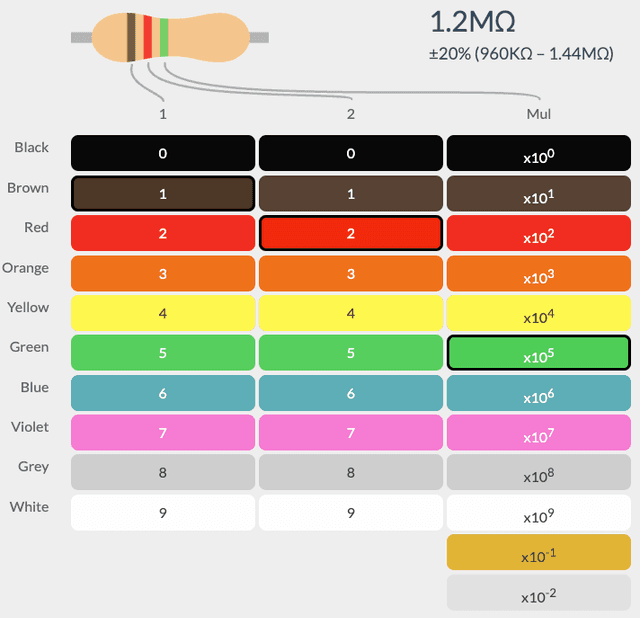Resistor Color Code Chart - The Ultimate Guide to Decoding Resistor Values
Resistor Color Code Chart - The Ultimate Guide. Easily decode 4, 5 & 6 band resistor values with our comprehensive chart, printable PDF, & interactive calculator.
A resistor color code chart is an essential tool for electronics that helps decode the resistance value of resistors using their color bands. These colored bands serve as a standardized system to indicate the resistor's value, tolerance, and temperature coefficient.
Whether you're working with 4-band, 5-band, or 6-band resistors, understanding the color code chart is crucial for accurately identifying resistor values without the need for measurement tools.
Your Complete Guide to Resistor Color Codes
Our comprehensive resistor color code chart provides:
- Detailed color code reference for all resistor types
- Easy-to-follow value calculation guides
- Printable color code chart for quick reference
- Interactive tools to help you decode resistor values
Whether you're a beginner learning about electronic components or an experienced engineer needing a quick reference, our resistor value color code chart offers the most accurate and user-friendly way to identify resistor values.
Easy-to-Read Resistor Color Code Chart
A comprehensive guide for 4-band, 5-band, and 6-band resistors. Use this printable chart to quickly identify resistor values.
| Color | Band 1 & 2 (4-band) Band 1, 2 & 3 (5/6-band) | Band 3 (4-band) Band 4 (5/6-band) | Band 4 (4-band) Band 5 (5/6-band) | Band 6 (6-band only) |
|---|---|---|---|---|
Black | 0 | ×1Ω (10⁰) | - | - |
Brown | 1 | ×10Ω (10¹) | ±1% | 100 ppm/°C |
Red | 2 | ×100Ω (10²) | ±2% | 50 ppm/°C |
Orange | 3 | ×1kΩ (10³) | - | 15 ppm/°C |
Yellow | 4 | ×10kΩ (10⁴) | - | 25 ppm/°C |
Green | 5 | ×100kΩ (10⁵) | ±0.5% | 20 ppm/°C |
Blue | 6 | ×1MΩ (10⁶) | ±0.25% | 10 ppm/°C |
Violet | 7 | ×10MΩ (10⁷) | ±0.1% | 5 ppm/°C |
Grey | 8 | ×100MΩ (10⁸) | ±0.05% | 1 ppm/°C |
White | 9 | ×1GΩ (10⁹) | - | - |
Gold | - | ×0.1Ω (10⁻¹) | ±5% | - |
Silver | - | ×0.01Ω (10⁻²) | ±10% | - |
How to Read the Color Code Chart
- 4-band resistors: First 2 bands are digits, 3rd is multiplier, 4th is tolerance
- 5-band resistors: First 3 bands are digits, 4th is multiplier, 5th is tolerance
- 6-band resistors: Same as 5-band plus temperature coefficient as the 6th band
How to Read Different Types of Resistor Color Codes
3-band Resistor Color Code Chart

The simplest and oldest type of resistors (rarely used today)
Band Reading Guide:
- 1st Band: First significant digit
- 2nd Band: Second significant digit
- 3rd Band: Multiplier
4-band Resistor Color Code Chart

The most common type for general electronics
Band Reading Guide:
- 1st Band: First significant digit
- 2nd Band: Second significant digit
- 3rd Band: Multiplier
- 4th Band: Tolerance
5-band Resistor Color Code Chart

Used for higher precision resistors
Band Reading Guide:
- 1st Band: First significant digit
- 2nd Band: Second significant digit
- 3rd Band: Third significant digit
- 4th Band: Multiplier
- 5th Band: Tolerance
6-band Resistor Color Code Chart

Highest precision with temperature coefficient
Band Reading Guide:
- 1st Band: First significant digit
- 2nd Band: Second significant digit
- 3rd Band: Third significant digit
- 4th Band: Multiplier
- 5th Band: Tolerance
- 6th Band: Temperature Coefficient
Quick Guide to Reading Resistor Color Codes
Example Calculation:
For a 4-band resistor with Brown-Red-Orange-Gold bands:
- Brown (1st band) = 1
- Red (2nd band) = 2
- Orange (3rd band) = × 1,000
- Gold (4th band) = ±5% tolerance
- Final value: 12,000Ω or 12kΩ ±5%
Understanding resistor color codes is essential for electronics projects. Whether you're working with 3-band, 4-band, 5-band, or 6-band resistors, this comprehensive guide helps you accurately identify resistor values.
Note: For the most accurate readings, always use a multimeter to verify resistor values in critical applications. This color code chart serves as a quick reference guide for identifying resistor values.
Download Printable Resistor Color Code Chart
Get our high-quality, printable PDF version of the resistor color code chart. Perfect for your workbench or lab reference.
The PDF includes:
- Complete 4-band, 5-band, and 6-band resistor charts
- Quick reference guide for value calculation
- High-resolution color codes and band explanations
- Printer-friendly layout and formatting
Our printable resistor color code chart is regularly updated to ensure accuracy and includes all standard resistor types. Perfect for electronics enthusiasts, students, and professionals.
Frequently Asked Questions About Resistor Color Codes
Find answers to common questions about reading and interpreting resistor color codes, tolerance bands, and proper identification techniques.
Still have questions about resistor color codes? Check our detailed guides or use our interactive resistor calculator for precise value calculations.